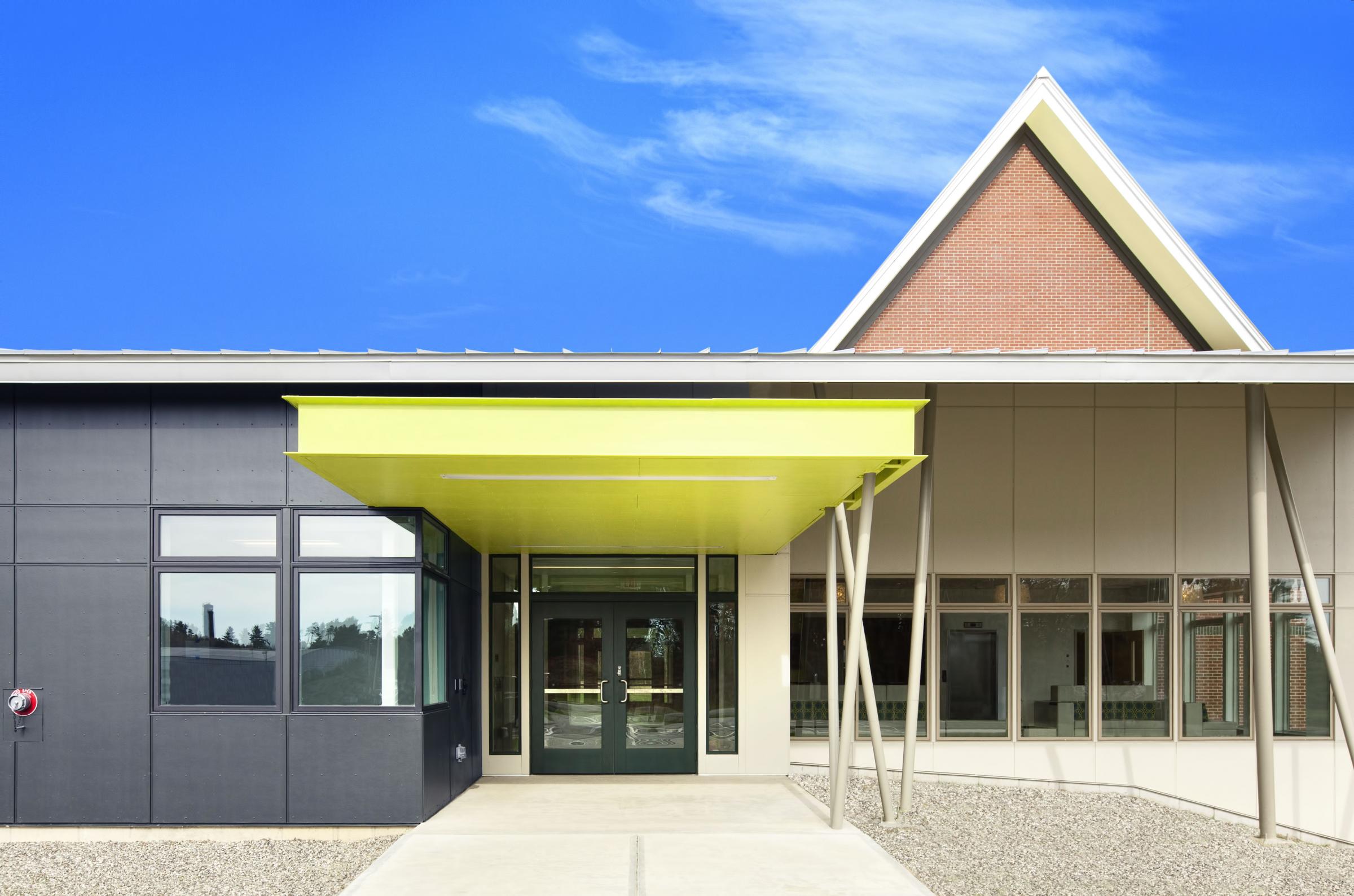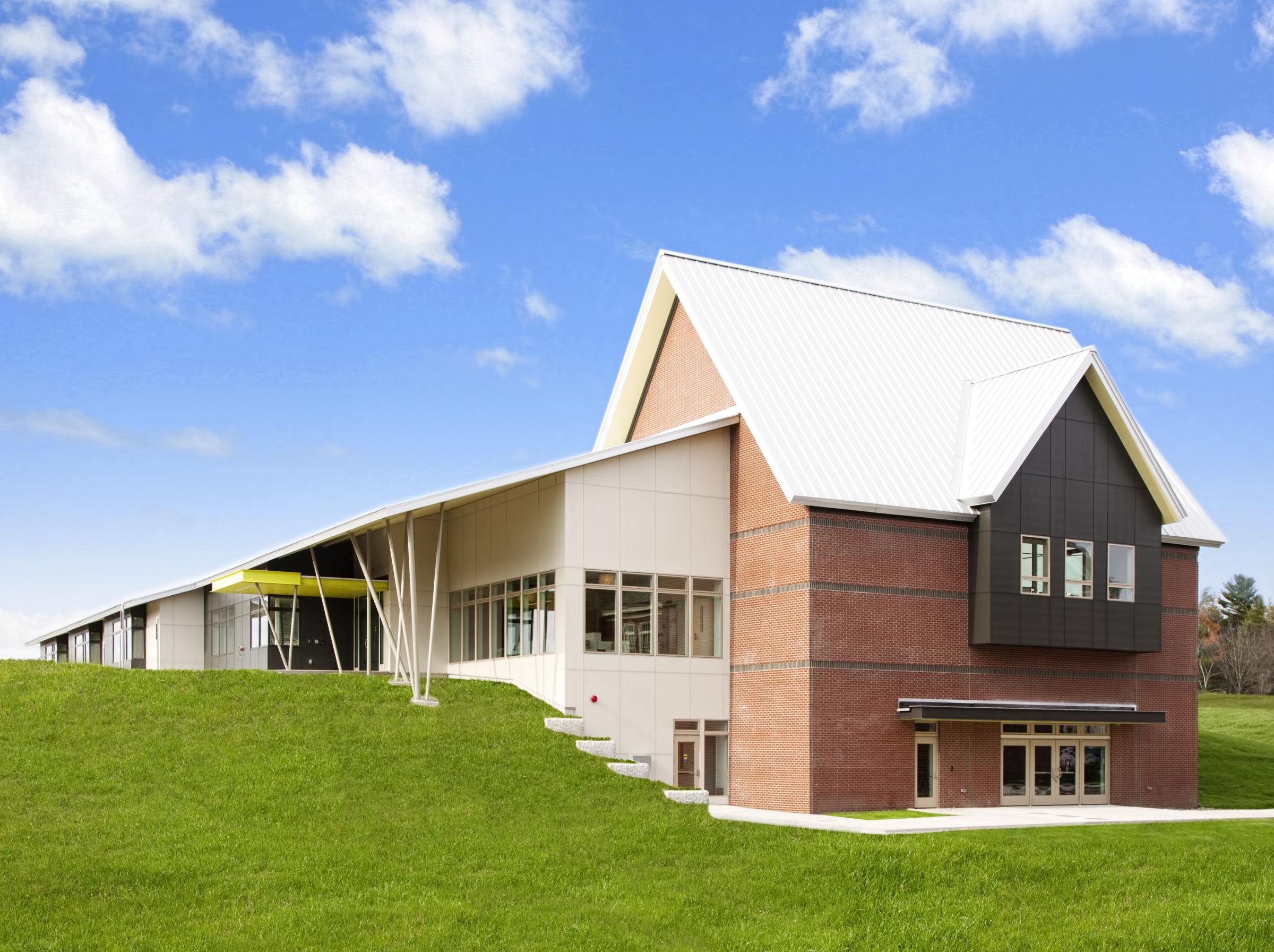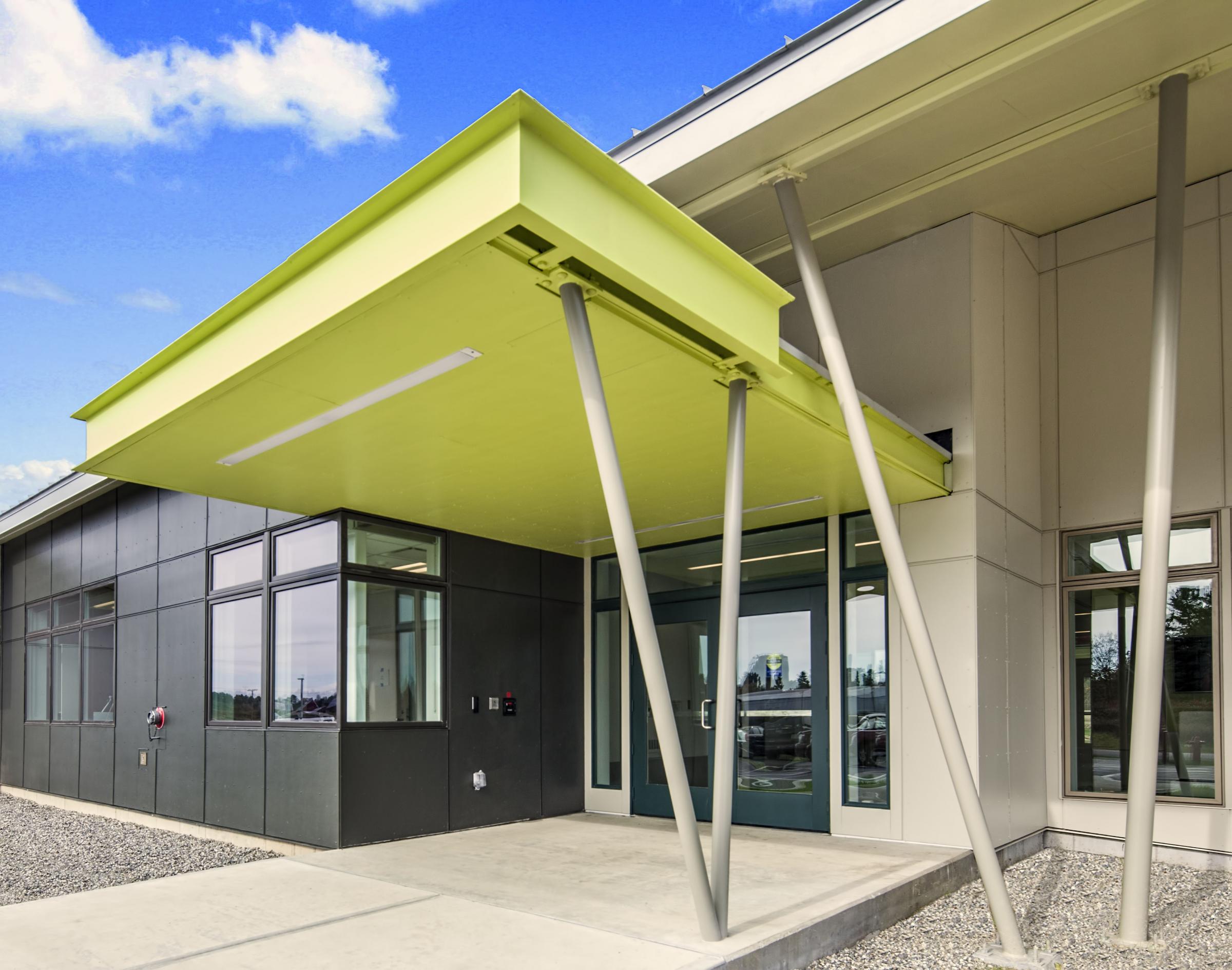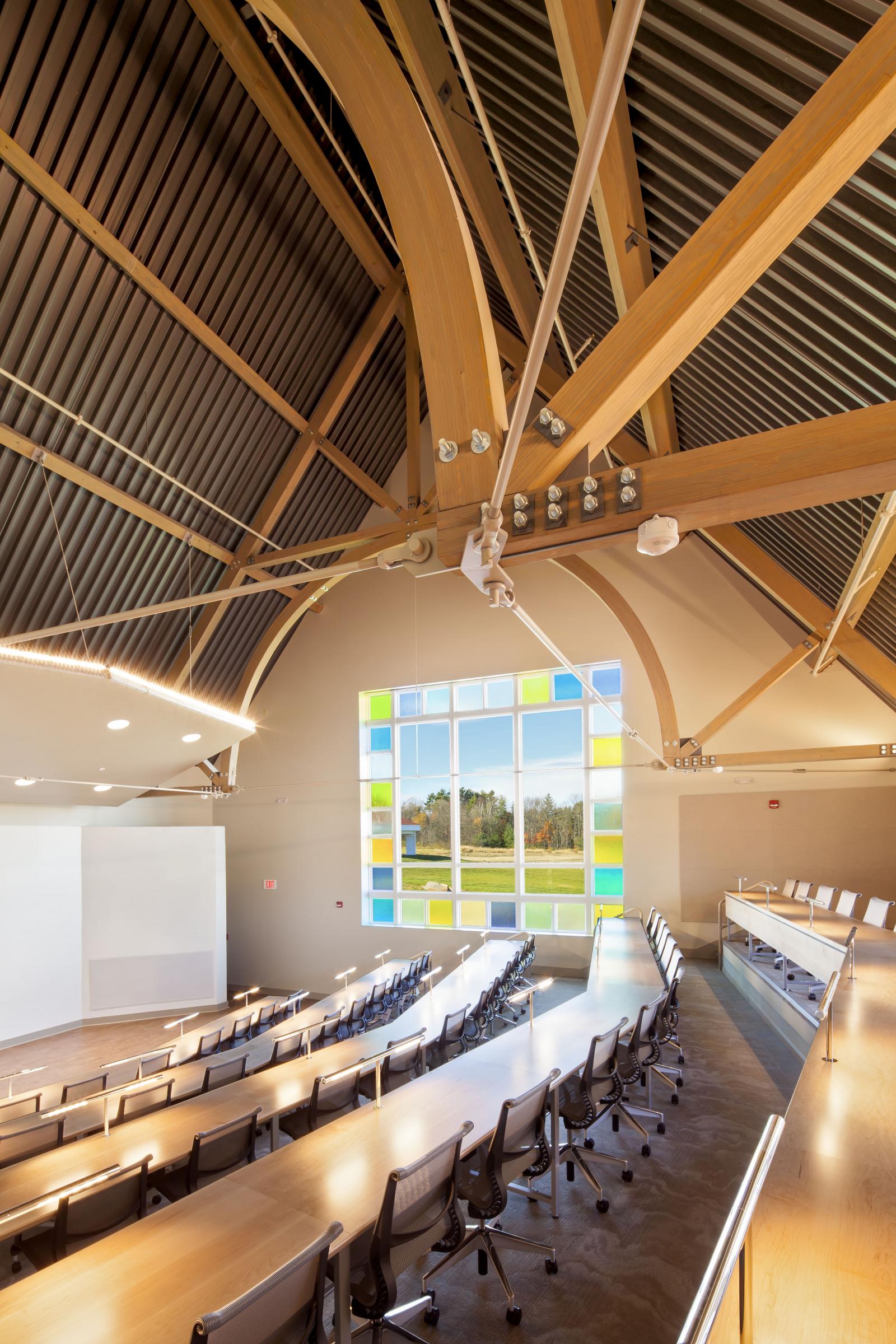Project Subtitle:
Project Description:
With the acquisition of nearly 800 acres of land, Kennebec Valley Community College is developing the Alfond Campus. SMRT designed the first new building on the site, a laboratory and classroom building that includes 3 labs; food prep/packaging, soils research and general science lab, classrooms, a computer lab, a 60-seat tiered auditorium and student lounge and informal learning space. With a goal of getting as close to NetZero as possible with the available budget, the building is a model for future development on the campus.
Building Type Summary:
Address:
Elevation:
Lat. / Long.:
Location Type:
Köppen Climate Type:
Climate Region:
Annual HDD :
Annual CDD:
HDD Base Temp:
CDD Base Temp:
Occupancy Type and Details:
The building is owner-occupied; it is open approximately 360 days per year. During a typical week there are between 10-20 staff/faculty members there full-time. The lecture hall seats 60 people and is occupied 30% of the time. The classrooms and labs can accommodate a total of 150 students and are occupied approximately 50% of the time.
Conditioned Floor Area:
Conditioned Building Volume:
Unconditioned Floor Area:
Multiple buildings?:
Total number of units in project (all buildings):
Total floor area of project (all buildings):
Historic?:
Completion date:
Site description:
The 600 acre site is a portion of the former Goodwill-Hinckley campus located in Hinckley, ME. The site houses a few existing school buildings, such as a former middle school, a recreation center, pavilion, and a chapel. Also located on the site are numerous farming buildings to support the fully functioning KVCC farm.
Materials:
One of the challenges of the project was to accommodate the owner's request to use sustainable, local materials, as well as zero maintenance materials on a very tight budget. The glu-lam beams used in the lecture hall were sourced locally from sustainable wood. Local brick was used on the exterior, along with fiber cement board. Due to the tight budget, the energy model was key in informing the best use of insulation for the building envelope and window types. Numerous configurations were tested in the energy model which helped determine the best return on investment for the budget. For instance, we were able to go with double pane windows on the south face of the building and triple pane on the north face, thus saving the client money.
Energy Highlights:
Sixteen (16) closed loop geothermal wells were provided, each at 340 feet deep. The wells provide approximately 34 Tons of cooling and 320 MBH of heating.
The PV array is sized for 195,000 kwh/yr, to offset the expected 104,000 kWh/year in building energy use, and well as energy consumption of (2) propane fired kitchen ranges.
Annual renewable energy generated:
Subslab assembly:
4" reinforced concrete slab, vapor retarder beneath entire slab, 2" rigid insulation
Foundation wall assembly:
Foundation wall is 1'- 1 1/2" thick and 5'-0" deep with 2" thick rigid insulation board on inside of wall.
Above grade wall assembly:
There are 2 main types of wall assemblies:
1) fiber cement siding on furring strips at 16" O.C., 3" rigid insulation, 5/8" modified bituminous sheet air barrier, sheathing, 6" metal studs, 5/8" gypsum board interior.
2) face brick, 2" air space, 3" rigid insulation, 5/8" modified bituminous sheet air barrier, sheathing, 8" metal studs, 5/8" gypsum board interior
Flat attic assembly:
Standing seam metal roof, self-adhered roof underlayment, roof sheathing, R-50 blown-in insulation, plastic sheet air barrier at bottom of truss, 5/8" gypsum board ceiling
Cathedral ceiling assembly:
standing seam metal roof, self-adhered roof underlayment, roof sheathing, 1 1/2" air space, structural insulated panel, plastic sheet air barrier, acoustical rated roof decking.
Door Area:
Space heating - Manufacturer & Model:
Space heating - capacity:
Domestic hot water - Manufacturer & Model:
Domestic hot water - capacity:
Domestic hot water - efficiency:
Ventilation - Manufacturer & Model:
Process:
This project used a standard Design-Bid-Build process. During the design phase numerous sustainability charrettes were held with the school to determine the best approach for achieving Net Zero. We studied numerous systems and their associated costs and weighed that with which systems the staff would be comfortable with maintaining.
Design for Adaptability:
The classrooms in the building could easily be adapted for other uses. The lounge space on the lower level could be converted to classrooms in the future.
Other Software tools:
Revit
Energy Modeling Software:
Trane Trace 700 v6.2.10
Outcome of project goals:
The goal to design a sustainable building on a tight budget was achieved by the team collectively making it a priority throughout the design process. The goal to achieve net zero site has yet to be realized because the PV panels have not been installed yet.
Total Cost of Project:
Construction hard cost:
Special architectural measures:
The energy model was used to determine the best solar orientation for the building based on the fact that we were using solar panels on the roof. We determined that we needed a 10,000 SF photovoltaic array to support the building's electric load. In order to get this amount of square footage on the southern facing roof, the building was designed with an offset roof with a 4/12 pitch on the south side and a 12/12 pitch on the north side. The labs are located on the south side of the building, each with large bay window bump-outs. These bumpouts not only provide great views, but take advantage of the solar heat gain and are prime locations for growing fruits, vegetables, and herbs in a climate with such a short growing season.
Energy Strategies:
Mechanical system provide heating and cooling via distributed water to air heat pump. The building ventilation was provided with a dedicated outside air unit (DOAS) with an enthalpy type energy recovery unit. The DOAS also had an integral water to air heat pump.
Lighting was predominantly energy efficient T8 with LEDs used for downlights and exterior lighting. T8s proved to have a long payback compared to their relatively low initial cost for general use linear fixtures.
Subslab R-value:
Slab edge R-value:
Foundation wall R-value:
Above grade wall R-value:
Flat attic R-value:
Cathedral ceiling R-value:
Average window U-factor:
Solar Heat Gain Coefficient:
Visible Light Transmittance:
Door U-Factor:
Cost per square foot of Conditioned Space:
Project Photos:





Number of Bathrooms:
Site conditions:
Renewable Energy Sources:
Summary of enclosure strategy/description:
The ASHRAE building envelope trade-off option was used for the project. The general approach was use the insulation on the exterior of the envelope.
Window Description:
Aluminum clad wood windows, low-e, triple pane with decorative stained glass - Marvin
Aluminum clad wood window - low-e, double pane - Pella
Fiberglass windows - low-e, double pane - Pella
Door Description:
Aluminum clad wood commercial doors - Low-e with argon - Pella
Aluminum clad wood sliding doors - Low-e with argon - Pella.
Number of Bedrooms:
Team Members:
Paul Lewandowski, Principal, formerly with SMRT
Kristen Damuth, Project Manager, SMRT
Nicole Rogers, Architect, SMRT
Tim McDonald, Architectural Designer, SMRT
Kerry Dineen, Mechanical Engineer, SMRT
William Heil, Electrical Engineer, SMRT
Phil Newcombe, Facilities, KVCC
Rick Hopper, President, KVCC
Bill Behrens, ReVision Energy
Jeana Stewart, Interior Designer
